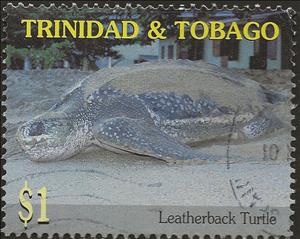Stamp: Leatherback turtle (Trinidad and Tobago 2001)
Leatherback turtle (Trinidad and Tobago 2001)
06 February (Trinidad and Tobago ) within release Endangered Fauna goes into circulation Stamp Leatherback turtle face value 1 Trinidad and Tobago dollar
| Stamp Leatherback turtle in catalogues | |
|---|---|
| Michel: | Mi: TT 706 |
| Stanley Gibbons: | Sg: TT 898 |
Stamp is square format.
Also in the issue Endangered Fauna:
- Stamp - Pacca face value 25;
- Stamp - Weeping capuchin monkey face value 4;
- Stamp - River otter face value 5;
- Stamp - Ocelot face value 10;
- Stamp - Trinidad piping guan face value 20;
- Stamp - Iguana face value 75;
- Stamp - Red Howler Monkey face value 3;
- Stamp - Golden Tegu face value 2;
- Stamp - Leatherback turtle face value 1;
- Stamp - Prehensile tailed Porcupine face value 50;
Stamp Leatherback turtle it reflects the thematic directions:
Animals are multicellular, eukaryotic organisms of the kingdom Animalia (also called Metazoa). All animals are motile, meaning they can move spontaneously and independently, at some point in their lives. Their body plan eventually becomes fixed as they develop, although some undergo a process of metamorphosis later on in their lives. All animals are heterotrophs: they must ingest other organisms or their products for sustenance.
Mammals are any vertebrates within the class Mammalia (/məˈmeɪli.ə/ from Latin mamma "breast"), a clade of endothermic amniotes distinguished from reptiles (including birds) by the possession of a neocortex (a region of the brain), hair, three middle ear bones and mammary glands. All female mammals nurse their young with milk, secreted from the mammary glands. Mammals include the largest animals on the planet, the great whales. The basic body type is a terrestrial quadruped, but some mammals are adapted for life at sea, in the air, in trees, underground or on two legs. The largest group of mammals, the placentals, have a placenta, which enables the feeding of the fetus during gestation. Mammals range in size from the 30–40 mm (1.2–1.6 in) bumblebee bat to the 30-meter (98 ft) blue whale. With the exception of the five species of monotreme (egg-laying mammals), all modern mammals give birth to live young. Most mammals, including the six most species-rich orders, belong to the placental group. The largest orders are the rodents, bats and Soricomorpha (shrews and allies). The next three biggest orders, depending on the biological classification scheme used, are the Primates (apes and monkeys), the Cetartiodactyla (whales and even-toed ungulates), and the Carnivora (cats, dogs, seals, and allies).
Turtles are reptiles of the order Testudines, characterized by a special shell developed mainly from their ribs. Modern turtles are divided into two major groups, the Pleurodira (side necked turtles) and Cryptodira (hidden necked turtles), which differ in the way the head retracts. There are 360 living and recently extinct species of turtles, including land-dwelling tortoises and freshwater terrapins. They are found on most continents, some islands and, in the case of sea turtles, much of the ocean. Like other amniotes (reptiles, birds, and mammals) they breathe air and do not lay eggs underwater, although many species live in or around water.



